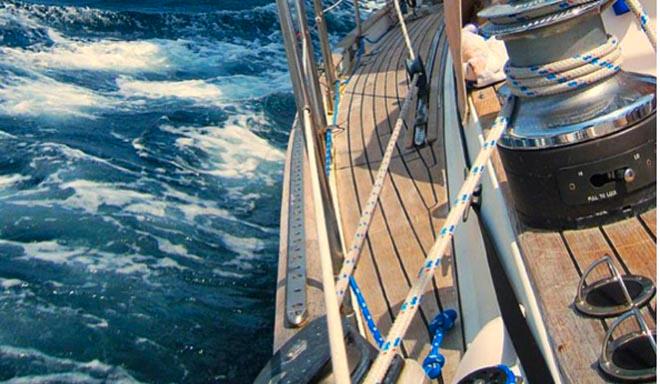Keep Clear of the 'Bight Line' for Sailing Safety!
by John Jamieson on 25 May 2013

Watch the bight! SW
How can you keep your boat and sailing crew safe when working a docking line under high tension? Make sure you put these three golden safety rules into play aboard your sailing boat, today!
Nylon makes the ideal line for docking because it can stretch like a rubber band. Your small sailing boat moves about when moored in her slip, alongside a pier, or while anchored. Wind, current, tidal rise and fall, sea waves, swell, or passing boat wakes are always at work. And these dynamic forces cause your docking or anchor line to tension and slack again and again.
Imagine that you stretch a big, thick rubber band to the breaking point. When it snaps, that rubber band has a ton of energy. Now, multiply that energy and picture a massive rubber band hundreds of times larger in motion. That's just what will happen if a nylon docking or anchor line snaps. The Coast Guard calls this 'snap back'. It could cause severe injury or death.
When a docking or towline snaps, it can act like a shell shot from a shotgun. Whatever it hits, it will smash, cut, gouge, or penetrate. Make line handling safety your #1 priority when docking your sailing boat. Remember that your heavy displacement vessel will pull on that docking line with tremendous force. Keep this in mind when you are working your boat alongside a pier or into a slip. Follow these three golden rules for safety's sake.
1. Beware of the Bight:
Keep clear of the bight of any line. For example, coil a line in a clockwise direction onto the deck. In nautical terms, the word 'bight' means loop. For example, if your coil a line, you make bights (loops) in the line.
Lines attached to your boat have a bight too, but the loop might not be as apparent. Think of any line under load as a 'bight-line'. Lines under load could be those used for docking, anchoring, raising a sail, or sheeting in a Genoa.
Think of a bight-line like this: START POINT--LINE--END POINT. The two points of the bight-line are the start and end attachment fittings (i.e. cleats, pilings, bits, winches, windlass gypsy heads, anchors). The line defines that area between the two points (i.e. line, chain). But, the bight-line will not always be a straight line. For example...
Note in the illustration below how the bight-line of the Genoa--the sheet shown in red--forms a loop. Imagine what would happen if one of those fittings in the loop gave way. The loop--under heavy tension--would act like a slingshot.
Anything inside the bight-line would be vulnerable to damage or serious injury. The best position for the crew would be outside of the loop, or bight of the sheet (bold black line in illustration).
Keep this in mind when working with any line or sheet or anchor rode. If you must enter the bite-line, get clear as soon as possible to prevent injury in case of line or fitting failure.
2. Cleat and Stand Aft:
As soon as your crew steps ashore with a line they must position themselves so that they are clear of the bight line. Remember POINT-LINE-POINT. Stand on the far side of the dock cleat or dock piling.
3. Work a Line Under Load:
Brief your crew on how to work a line under tension. Often, you will see crew stand next to a dock cleat with line in hand or just a half wrap around the cleat. This could cause injury. Follow this procedure:
Pull the line to the far side of the cleat. Next, wrap a full circle--called a 'round turn'--around the base of the cleat. This creates enough friction to prevent the line from slipping.
If you need to work the boat into the pier, by springing onto the line, you will need to be able to pull in and ease the line. If the cleat has enough room beneath the horns, use the round turn method to work the line. Unwrap the full round turn and pull the slack from the line. Then wrap the line back in a full round turn. You must do this in a quick, smooth motion. Watch the boat as you work the line. Work in harmony with the boat to help the skipper move it alongside the pier.
If the cleat does not have enough room beneath the horns, use the figure-8 method to work the line. Touch the line to the back of the cleat as described earlier. Wrap it over the top of the rear horn, then under the bottom of the forward horn. This forms a partial figure eight that offers good friction to keep the line from running free, but also allows the line to be eased to work the boat alongside the pier.
~~~~~~~~~~~~~~~~~~~~
Use these docking tips to keep your crew safe and sound when working with docking or anchoring lines. Practice these vital cruising skills to gain the skills you need--wherever in the world you choose to cruise!
John Jamieson (Captain John) with 25+ years of experience shows you the no-nonsense cruising skills you need for safer sailing worldwide. Visit his website at www.skippertips.com. Sign up for the Free, highly popular weekly 'Captain John's Sailing Tip-of-the-Week'. Discover how you can gain instant access to hundreds of sailing articles, videos, and e-Books!
If you want to link to this article then please use this URL: www.sail-world.com/109829